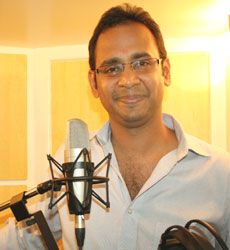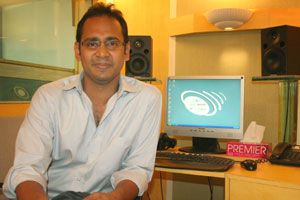

We have all wondered about the voices that infuse life into loving animated characters, sell us products in our drawing rooms and talk to us in their friendly voices on FM radio. These are the invisible voice over artists we hear every day; the unknown faces of the broadcasting industry.
One of the premium voice talents in the industry, Darrpan Mehta in conversation with Nasrin Sultana, sheds light on the voice and dubbing industry. Mehta heads Sugar Mediaz Private Limited, a broadcast content and talent solutions company and is founder director of The Voice School. A biker by passion, he is the anchor of Radio City Flashback and City Talkies on Radio City.
He has lent his voice for Sony, Zee, Sahara One, Discovery, and for a host of televised events like the Filmfare Awards, Indian Idol , Amul Star Voice of India, Sa Re Ga Ma Challenge and Indian Telly Awards.
Excerpts from a conversation -
With a huge growth in the FM sector, do you see any improvement in the language skills and voice modulation among the current crop of RJs?
I do not see any improvement. RJs are academically challenged. They just talk but are yet to become intelligent speakers. They also lack in language skills. What they do not understand is that humour is different from slapstick. Many of them are not fluent in Hindi; they do a word-to-word translation from English to Hindi. For instance, they say,
"Hum aapke ke leye gaana khelne wala hain (we are going to play a song for you)."
There's consensus in the industry that the FM content is cluttered. What could work as a clutter breaker?
I think the radio future lies in skits, which are two or three minutes long. I am not talking about the Hawa Mahal kind of skits that used to air on Vividh Bharati. Now is the time when everyone opts for fast food. What's required are interesting stories or capsules that could be built around each station's own property.
The dubbed content market has seen a boost with many upcoming channels entirely dependent on it. How do you see it?
I am the voice of Sahara One Media and Entertainment's upcoming dubbed content channel Firangi. Most of the new general entertainment channels (GEC) have dubbed content. It has grown over the years, while earlier it was virtually non-existent. Now it is on the threshold of becoming a mega industry in its own right.
On the other hand, it is a dichotomy actually. If you view it from an entrepreneur's point of view, it is a big business opportunity for a huge market that's coming up. We have access to a market that is booming. But as an artist, I feel that on the content side, there has been a downfall. Since the production houses involved in dubbing always go in for cost cutting, they do not place a high value on a premium artist. They would rather compromise on the voice quality.
Even for a theatrical release, the dubbing production houses use a premium voice but for the home video and satellite screening, a low cost dubbing artist is used to cut costs. All the films are re-dubbed for TV release and the home video release.
Does content and sensuality of the language suffer in the process of dubbing?
A joke in English cannot be translated. What is difficult is translating the story line into our language. For example, English humour is different from American humour and Indian humuor. Earlier, there used to be word to word translations, which really took its toll on the quality of the content. But now the trend is to trans-create, so that we can do justice to the ethos of the language, culture and sensibility. The way Pankaj Kapur trans-created Mind your language into Jabaan Sambhal Ke is commendable.
What are the costs involved in dubbing?
It is a wonderful low cost model. For example, acquiring a show from various parts of the world and putting it up as dubbed content is very cheap as against producing an entire show. The costs of producing a show can run into several hundred thousands, but a half hour of dubbed content will cost around Rs 50 to 60,000.
There are kids' channels and now GECs which have been synergizing dubbed content and building it as a strong proposition. But do you think dubbing artists are paid their due?
People always look down upon dubbed content and the dubbing artist. It is only if people like Shah Rukh Khan dub for Hum Hain Lajawaab, that it makes headlines.
Dubbing is to voicing, what theatre is to acting. Dubbing is a tough thing. What we do is, an English audio called the pilot track plays on the head phone of the artist, the dubbing artist's voice plays on the second track in the headphone, then there is a script in front of the artist. Above all, I have to be with the character but not lead him or follow him. Besides everything, the artist has to emote the characters that he is rendering his voice for. We have to do natural reflexes. Behind the scenes, it is a challenging and a creative thing to do.
What is the most difficult task in dubbing?
For a dubbing artist, it is a difficult task to match the lip sync of the characters, who are speaking some other language. Whatever number of words are spoken in a minute, it is not necessary to have the same number of words in the translated language. There, we have to match the timing as well the lip sync.
Is it tougher to dub south Indian languages into Hindi than dubbing English into Hindi?
It is always a tough job to dub from South Indian languages to Hindi than English to Hindi because South Indian languages are spoken very fast. It is difficult to lip sync the South Indian languages.
Unlike singers, do voice over artists and dubbing artists have any licensing rights?
Not really. The voice over artist and dubbing artist community is very unorganized and scattered. Only the premium voice over artist in India get licensing rights for their voice.
If an artist gives his voice for any show in India, the broadcaster can use the voice any number of times. But it is not the same in other countries. Even the Copyright Act of India, 1952, guarantees copyright to any individual voice artist. Only in the advertising industry does the voice artist get royalty each time the voice is used, but in the case of dubbing, it is not only an one time payment to the dubbing artist.
Internationally, a dubbing artist might do one film per year but he can sustain himself the entire year with the kind of royalty that he gets, based on the regulations and the kind of contract that he signs.
Have you tried seeking licensing rights from broadcasters?
For ads yes, but for promos they cannot and do not use the same voice for a TV ad and a radio ad, as per regulations. In ads, big time artists are getting their dues these days.
Which are the ventures that Sugar Mediaz is involved with?
Sugar Mediaz Private Limited is a broadcast content and talent solutions company incorporated in 2004. It has three divisions which work in tandem to propel the company's objective of ensuring the best talent training platform and developing innovative and fresh content for the broadcast industry. We produce content catering to the needs of the radio/ television promotion and corporate communication industry.
Our list of clients includes Mudra Communications, O & M, Network Advertising, JWT, Zee Telefilms, Star Television, Sony Entertainment television, Hum FM Dubai.
What about your voice training school?
The Voice School is a training facility for any kind of voice training in radio talent, voice over talent, corporate voice training or public speaking and personality grooming skills.
We have our own recording studios. We have an archive of 700 radio commercials.
Scores of aspiring voice professionals are today working with some of the leading names in the broadcast industry in India and abroad like Big FM, Radio City, Hum FM, Dubai, City FM, Dubai, Aawaz FM, Dubai, Radio 4 Dubai.